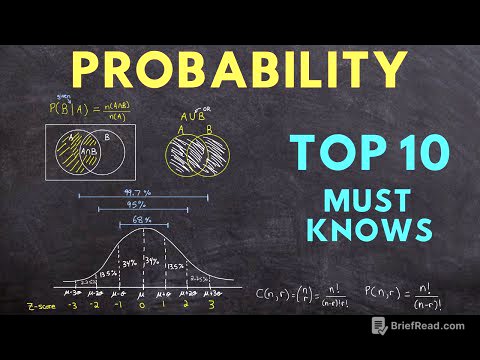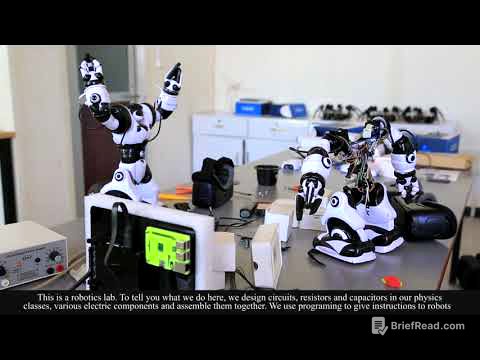TLDR;
This YouTube video provides a comprehensive overview of key concepts in physical chemistry for 11th-grade science students. It covers topics ranging from basic concepts like the mole concept and laws of chemical combination to more advanced topics such as redox reactions, chemical equilibrium, thermodynamics, and atomic structure. The lecture aims to solve students' problems by explaining the topics from basic to advanced level.
- Mole concept and chemical combinations
- Redox reactions and balancing
- Chemical equilibrium and factors affecting it
- Atomic structure and quantum numbers
- Thermodynamics concepts and applications
Introduction [0:00]
The instructor introduces himself and acknowledges the students' requests for physical chemistry lessons. He shares a story about being asked to conduct this class and expresses his commitment to addressing the students' concerns regarding physical chemistry.
Topics to be covered [2:20]
The instructor outlines the topics to be covered in the session, including the mole concept, redox reactions, chemical equilibrium, atomic structure, and thermodynamics. The goal is to complete the marathon in a short time, covering all topics from basic to advanced level.
Mole concept [3:54]
This chapter covers the laws of chemical combination, including the law of conservation of mass, the law of constant proportions, the law of multiple proportions, Gay-Lussac's law of gaseous volumes, and Avogadro's law.
The law of conservation of mass states that mass is conserved in a chemical reaction.
The law of constant proportions states that the ratio of elements in a compound is fixed.
The law of multiple proportions applies when two elements form more than one compound.
Gay-Lussac's law applies to gaseous volumes in reactions.
Avogadro's law states that equal volumes of gases contain equal numbers of molecules at the same temperature and pressure.
The lecture includes a question to identify which law of chemical combination applies to a given set of data, with the answer being the law of multiple proportions. Dalton's atomic theory is introduced, defining atoms as fundamental particles that can combine to form molecules and compounds. Elements are defined as atoms in their purest form, while molecules are combinations of the same or different atoms. Compounds, on the other hand, are combinations of different atoms.
Redox reduction [48:34]
The chapter starts with oxidation number method. Oxidation number is defined as the average charge per atom in a species. The rules for assigning oxidation numbers are explained, including that the oxidation number of elements in their free state is always zero. The oxidation number of group one elements is always +1, and fluorine is always -1. Hydrogen can be +1 or -1 depending on whether it is combined with a nonmetal or a metal, respectively. Oxygen typically has an oxidation number of -2, but it can be -1 in peroxides and -1/2 in superoxides.
The concept of oxidation and reduction is explained based on changes in oxidation number. Oxidation involves an increase in oxidation number, while reduction involves a decrease. Oxidizing and reducing agents are also defined. The chapter includes a question to identify the oxidizing and reducing agents in a given reaction.
Balancing redox reactions in acidic and basic media is discussed, using the half-reaction method. The steps include dividing the reaction into half-cells, balancing all atoms except hydrogen and oxygen, balancing hydrogen and oxygen using water and H+ or OH- ions, and balancing the charge by adding electrons.
Chemical Equilibrium [1:29:37]
The chapter begins by defining chemical equilibrium as a state where the rates of forward and backward reactions are equal, resulting in no net change in reactant and product concentrations. Reversible and irreversible reactions are distinguished. The conditions for equilibrium are discussed, including that it must occur in a closed vessel and that measurable properties like pressure, density, and concentration become constant.
The law of chemical equilibrium is explained, introducing the equilibrium constant (Kc) as the ratio of product to reactant concentrations at equilibrium. The relationship between Kc and Kp is also discussed. The concept of the reaction quotient (Q) is introduced to predict the direction a reaction will shift to reach equilibrium. If Q > Kc, the reaction will move backward; if Q < Kc, it will move forward; and if Q = Kc, the reaction is at equilibrium.
Methods for finding the equilibrium constant for homogeneous and heterogeneous equilibria are explained. The concept of the degree of dissociation is introduced. Le Chatelier's principle is discussed, explaining how changes in concentration, pressure, and temperature affect equilibrium. The effect of adding an inert gas at constant volume and constant pressure is also covered.
Structure of atom [2:42:43]
The chapter starts with the discovery of fundamental particles, including electrons, protons, and neutrons. Crookes' tube experiment is explained, which led to the discovery of cathode rays and electrons. The properties of cathode rays are discussed, including their ability to produce sharp shadows, deflection in electric fields, and mechanical properties.
Thomson's model of the atom is introduced, describing the atom as a sphere of positive charge with electrons embedded in it. The limitations of Thomson's model are discussed, leading to Rutherford's alpha particle scattering experiment. The observations and conclusions from Rutherford's experiment are explained, including the concept of the nucleus.
Bohr's model of the atom is presented, stating that electrons revolve around the nucleus in specific orbits with fixed energy. The limitations of Bohr's model are also discussed. The de Broglie concept of wave-particle duality is introduced, stating that electrons have both wave and particle nature. Heisenberg's uncertainty principle is explained, stating that it is impossible to simultaneously measure the position and momentum of an electron with absolute accuracy.
Quantum numbers are introduced, including the principal quantum number (n), azimuthal quantum number (l), magnetic quantum number (ml), and spin quantum number (ms). The significance of each quantum number is explained. The shapes of atomic orbitals, including s, p, and d orbitals, are discussed. The chapter concludes with Hund's rule of maximum multiplicity and the Aufbau principle.
Thermodynamics [3:31:13]
The chapter begins by defining thermodynamics and its importance in predicting the feasibility and spontaneity of a process. The limitations of thermodynamics are discussed, including that it applies only to matter in bulk and does not provide information about the rate of a reaction.
Basic terminology is introduced, including system, surroundings, and boundary. Types of systems are defined, including isolated, closed, and open systems. Thermodynamic properties are classified as intensive or extensive, with intensive properties not depending on the quantity of matter and extensive properties depending on the quantity of matter. State functions and path functions are distinguished, with state functions depending only on the initial and final states and path functions depending on the path of the process.
Types of thermodynamic processes are defined, including isothermal, adiabatic, isobaric, isochoric, and cyclic processes. The chapter concludes with a discussion of heat, work, and internal energy.
Thank You Bacchon [4:07:31]
The instructor thanks the students.









